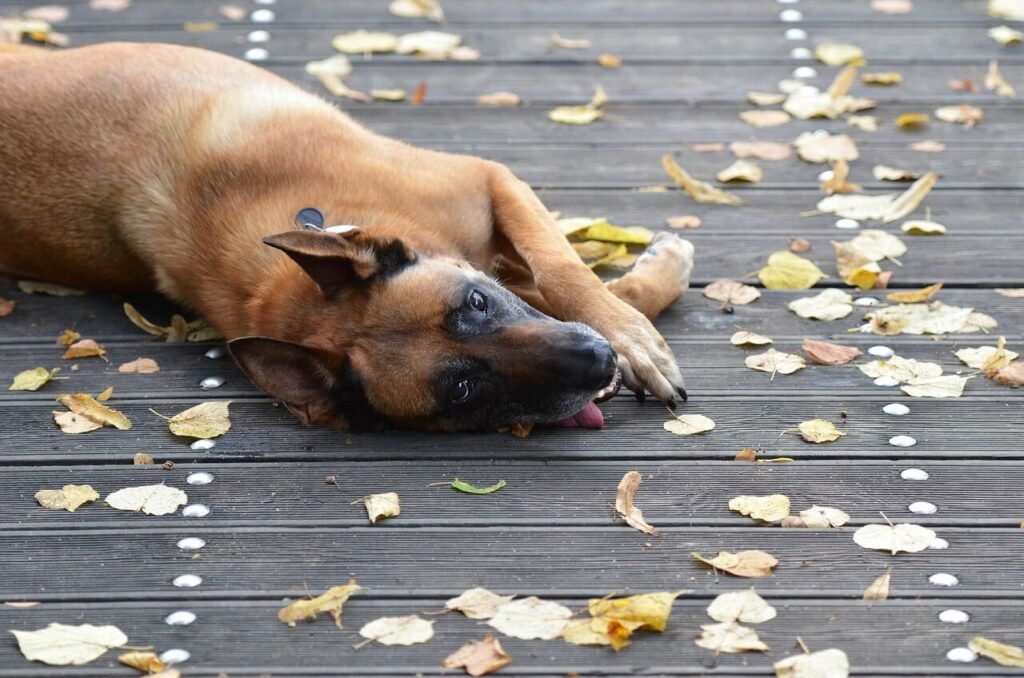Can Dogs Get Hemorrhoids? What Every Pet Owner Needs to Know
If you’ve ever wondered, “Can dogs get hemorrhoids?” —you’re not alone. Many pet owners are curious about whether their furry friends can experience this uncomfortable condition. While dogs don’t develop hemorrhoids in the same way humans do, they can suffer from similar anal and rectal issues that mimic the symptoms. Understanding these conditions is crucial for ensuring your dog stays healthy and comfortable. In this blog post, we’ll explore everything you need to know about hemorrhoid-like symptoms in dogs, including causes, prevention, and treatment options. Let’s dive in and clear up the confusion surrounding this topic!
What Are Hemorrhoids—and Can Dogs Really Get Them?
While the term “hemorrhoids” is commonly associated with human health, it’s important to clarify what this means for dogs. Here’s a breakdown of the facts:
Hemorrhoids Defined
Hemorrhoids are swollen blood vessels in or around the anus, typically caused by increased pressure. While common in humans, dogs rarely experience true hemorrhoids.Similar Conditions in Dogs
Dogs are more likely to suffer from anal gland issues, perianal fistulas, or tumors that cause symptoms resembling hemorrhoids.Anatomy Differences
A dog’s anatomy makes them less prone to developing hemorrhoids compared to humans, but their anal region is still susceptible to other problems.Symptoms That Mimic Hemorrhoids
Redness, swelling, or discomfort around the anus can occur in dogs due to various health issues unrelated to hemorrhoids.Veterinary Diagnosis
If you suspect your dog has hemorrhoid-like symptoms, a vet can determine the underlying cause through a thorough examination.
Understanding these distinctions helps pet owners address their dog’s symptoms accurately. Always consult a professional to rule out serious conditions.
Common Causes of Anal Issues in Dogs
Several factors can contribute to anal problems in dogs, which may be mistaken for hemorrhoids. Identifying the root cause is essential for proper treatment.
Anal Gland Impaction
When a dog’s anal glands become blocked, they can swell and cause discomfort similar to hemorrhoids.Infections or Abscesses
Bacterial infections in the anal area can lead to swelling, pain, and discharge, mimicking hemorrhoid symptoms.Obesity
Excess weight can put pressure on a dog’s rectal area, increasing the likelihood of irritation or swelling.Dietary Issues
A lack of fiber or poor digestion can result in straining during bowel movements, which may irritate the anal region.Allergies or Skin Conditions
Allergic reactions or dermatitis around the anus can cause redness, itching, and inflammation.
By addressing these potential causes, you can help prevent or alleviate your dog’s discomfort. Early intervention is key to keeping your pup healthy and happy.
Check this guide 👉Signs Your Dog Needs Anal Glands Expressed: Best 7 Tips
Check this guide 👉Best 7 Expert Tips Why Your Dog is Pooping Blood!
Check this guide 👉Why Is My Dog Scooting Their Butt on the Floor? Best 7 Tips!

Symptoms of Anal Issues in Dogs | Possible Causes |
|---|---|
Swelling around the anus | Anal gland impaction |
Scooting on the floor | Full or infected anal glands |
Redness or irritation | Allergies or infections |
Straining during bowel movements | Constipation or dietary issues |
Discharge or bleeding | Abscesses or tumors |
How to Prevent Anal Problems in Dogs
Prevention is always better than cure when it comes to your dog’s health. Here are some practical steps to reduce the risk of anal issues:
Maintain a Healthy Diet
Feed your dog high-quality food rich in fiber to promote regular bowel movements and reduce straining.Monitor Weight
Keep your dog at a healthy weight to prevent excess pressure on their anal region.Regular Exercise
Physical activity supports digestion and helps maintain a healthy weight, reducing the risk of constipation.Check Anal Glands Regularly
Schedule routine check-ups with your vet to ensure your dog’s anal glands are functioning properly.Keep the Area Clean
Gently clean your dog’s anal area if it becomes dirty or irritated, using pet-safe wipes or warm water.
By taking these preventive measures, you can minimize the chances of your dog developing anal problems. Proactive care ensures a happier, healthier pup!
Treatment Options for Anal Issues in Dogs
If your dog is experiencing anal problems, there are several treatment options available depending on the underlying cause. Here’s what you need to know:
Expressing Anal Glands
A vet or groomer can manually express impacted anal glands to relieve discomfort and prevent infection.Medications
Antibiotics or anti-inflammatory drugs may be prescribed to treat infections or reduce swelling.Surgical Intervention
In severe cases, such as perianal fistulas or tumors, surgery may be necessary to address the issue.Dietary Supplements
Adding fiber supplements or probiotics to your dog’s diet can improve digestion and reduce strain during bowel movements.Topical Treatments
Creams or ointments can soothe irritated skin and promote healing in mild cases.
The right treatment depends on the specific condition affecting your dog. Always consult your vet for an accurate diagnosis and tailored care plan.
Signs Your Dog May Have an Anal Issue
Recognizing the signs of anal problems in dogs is crucial for early intervention. Here are some common symptoms to watch for:
Excessive Licking or Biting
If your dog is constantly licking or biting around their anus, it could indicate irritation or discomfort.Scooting Across the Floor
This behavior often signals anal gland issues, as dogs try to relieve pressure by dragging their rear end.Visible Swelling or Redness
Swelling or redness around the anus may point to inflammation, infection, or other anal problems.Foul Odor
A strong, unpleasant smell near your dog’s rear could suggest impacted or infected anal glands.Straining During Bowel Movements
Difficulty passing stool may indicate blockages or irritation in the anal region.
By paying attention to these signs, you can address potential issues before they worsen. Early detection is key to keeping your dog comfortable and healthy.
Common Misconceptions About Hemorrhoids in Dogs
There are several myths about hemorrhoids in dogs that can lead to confusion. Clearing up these misconceptions helps pet owners make informed decisions.
“Dogs Get Hemorrhoids Just Like Humans.”
While dogs can experience similar symptoms, true hemorrhoids are extremely rare in canines.“Scooting Always Means Hemorrhoids.”
Scooting is more likely caused by anal gland issues than actual hemorrhoids.“Hemorrhoids Are the Only Cause of Anal Swelling.”
Other conditions, such as infections or tumors, can also cause swelling in the anal area.“Over-the-Counter Human Treatments Work for Dogs.”
Human hemorrhoid creams or medications can be harmful to dogs and should never be used without veterinary approval.“Anal Issues Are Always Serious.”
While some conditions require immediate care, others can be resolved with simple treatments like dietary changes.
Understanding these facts ensures you approach your dog’s health with accurate information. Always consult a vet for proper diagnosis and treatment.
Ways to Support Your Dog’s Digestive Health
A healthy digestive system plays a vital role in preventing anal issues in dogs. Here are some ways to support your dog’s digestive health:
Provide a Balanced Diet
Feed your dog high-quality food that includes essential nutrients and fiber to promote regular bowel movements.Incorporate Probiotics
Probiotic supplements can improve gut health and reduce the risk of constipation or diarrhea.Ensure Proper Hydration
Make sure your dog has access to fresh water at all times to prevent dehydration and support digestion.Avoid Sudden Dietary Changes
Gradually transition your dog to new foods to avoid upsetting their stomach and causing digestive issues.Monitor Food Intolerances
Identify and eliminate any ingredients that trigger allergic reactions or digestive upset in your dog.
By prioritizing your dog’s digestive health, you can reduce the likelihood of anal problems and ensure overall well-being. A happy gut leads to a happy dog!
FAQ
Can dogs really get hemorrhoids like humans?
No, dogs rarely develop true hemorrhoids, but they can experience similar symptoms due to other anal issues.
Why does my dog scoot on the floor?
Scooting is often a sign of impacted or inflamed anal glands, not hemorrhoids.
How can I tell if my dog has an anal gland problem?
Look for signs like scooting, licking the anal area, swelling, or a foul odor.
What should I do if my dog’s anus is swollen?
Consult your vet to determine the cause and receive appropriate treatment.
Can diet affect my dog’s anal health?
Yes, a lack of fiber or poor digestion can lead to straining and anal irritation.
Taking Care of Your Dog’s Anal Health
While dogs don’t get hemorrhoids in the traditional sense, they are still prone to a variety of anal issues that require attention. By staying informed about the symptoms, causes, and treatments, you can ensure your dog remains comfortable and healthy. Prevention plays a vital role, so focus on maintaining a balanced diet, regular exercise, and routine vet visits. If you notice any signs of discomfort or unusual behavior, don’t hesitate to seek professional advice. Your dog’s well-being is worth every effort, and with proper care, you can keep their tail wagging happily for years to come!
Why Is My Cats Second Eyelid Showing? Best 7 Expert Tips! Understand causes, health signs, and how to respond when your cat’s third eyelid becomes visible.
How Do I Know If My Cat Died Peacefully? Best 7 Expert Tips! Discover the quiet signs of a peaceful feline passing and find comfort in their final moments.
Cat Allergy Eyes: Best 7 Expert Tips! Discover why your eyes react to cats and learn proven strategies for relief—without giving up your feline friend.
Why Do Abyssinian Cat Colors Matter? Best 7 Expert Tips! Discover the genetics, rare hues, and care secrets behind Abyssinian coat colors for a healthier, happier cat.





